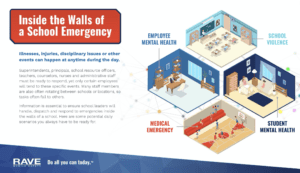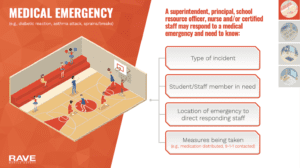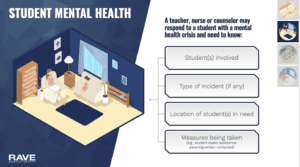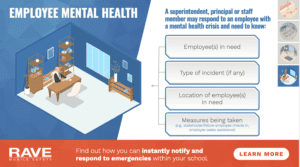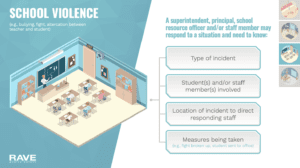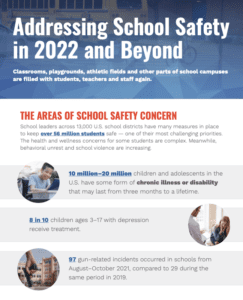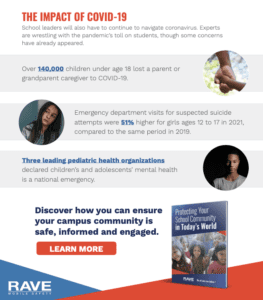K-12 School Emergency Preparedness: From the Inside Out
Superintendents, principals, school resource officers, teachers, counselors, nurses and administrative staff in over 13,000 school districts have returned to the classroom after almost 18 months of hybrid or remote learning. Staff members are doing their best to create a sense of new normalcy for students as they navigate the unknown, while still dealing with everyday emergencies.
What Kind of Emergencies Will Schools Face?
School staff deal with emergencies from everyday incidents to unpredictable catastrophes. Responding to these emergencies quickly and successfully is a matter of preparation. Some of these emergencies include:
- Medical emergencies, such as sprains, an asthma attack or a diabetic reaction, involve many complexities, requiring staff to be ready in a moment’s notice. Up to 20 million children and adolescents have some form of chronic illness or disability. As students return to school campuses, 50% of survey respondents said student physical health will also be a top concern.
- School violence, such as bullying or physical fights, pose another threat. In the opening weeks of the 2021-2022 school year, there has been an increase in physical fights. More than 400 fights were reported in Louisville, Kentucky. A greater number of fights were, also, reported in Annapolis, Maryland and Columbus, Ohio.
- Youth mental health has been a national crisis for years, but the extent to which students are struggling has escalated with COVID-19. A recent survey of K-12 students, conducted following stay-at-home orders, found that 51% of students reported feeling more stressed and 39% feel lonelier.
- Not only are the students struggling with their mental health, but employee mental health has become a major concern. Between May and October 2020, RAND Corporation researchers found that the number of K-12 educators seriously worried about burnout increased from 25% to 57%.
School Safety Drills Can Save Lives
During these school emergencies, anything can happen. Confusion, stress and anxiety may get in the way of quickly and successfully responding to these events. Schools can run safety drills, or exercises, which are often mandated, to practice procedures tan emergency situation. Some of these drills include shelter in place, fire, evacuation and lockdown.:
Solutions to Solve K-12 Emergencies
School safety drills are not the only thing you can do to prepare your school for emergencies. Having the proper tools and solutions can allow for easier crisis mitigation. Taking a closer look at different types of school emergencies, what information will you need and how can you best prepare for them? Regardless of the type of school emergency, accurate communication of information is essential. Superintendents, principals, school resource officers, teachers, counselors, nurses and administrative staff must be ready to respond. This becomes difficult when only certain employees may be at locations for a limited amount of time or at a specific event. Some staff members are also often rotating between schools or locations, so tasks often fall to others. In order to respond to these school emergencies, the necessary personnel must have accurate information, including the type of incident, the individuals involved, and the steps taken.
Rave Panic Button is another valuable resource for school emergencies. You can trigger a one– click activation of an emergency to instantly connect with 9-1-1 telecommunicators, first responders and necessary personnel for an immediate response. The Panic Button features include:
- Internal staff communication: enables authorized staff members to notify about minor medical accidents, security disruptions and administrative updates, without calling 9-1-1.
- Status checks: collect real-time updates from staff members, providing first responders with the location of the most urgent need for resources.
- Content directory: allow school leaders to make valuable documents like CPR instructions and evacuation routes available to Panic Button users right on their smartphones.
- Drill management: stay on top of your school’s or district’s drills and provide visibility into the history of activations, such as date range, participants and drill type.
- Incident Forms – Manage and complete custom forms right within Rave. Many schools have mandated drill report forms that they need to fill out after a drill has been performed. Replace paper forms with digital versions that can then be used to collect and store the information digitally, alongside the incident in Rave.
- Do Not Disturb Bypass – During an emergency, an activation of the panic button could be blocked if a teacher has their phone off or on silent – often required by policy in schools. If enabled, when the panic button goes off, it bypasses that, and still alerts any phone even if silenced or in Do Not Disturb mode.
With the proper tools and plans, school staff can be prepared for any kind of emergency. Coming up with a game plan and routinely practicing safety drills can be the difference between a fatal incident and a crisis averted. Preparing your school from the inside out and focusing on combatting medical emergencies, school violence, student mental health and employee mental health will foster a safer environment for everyone.


